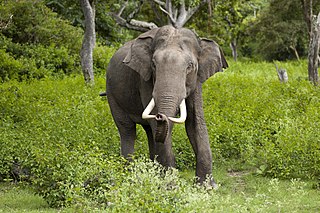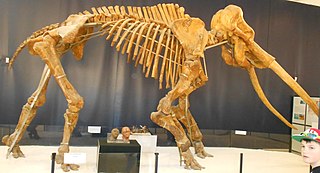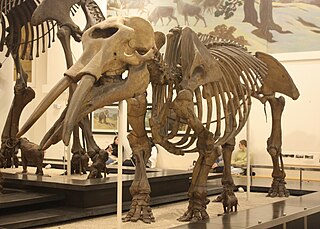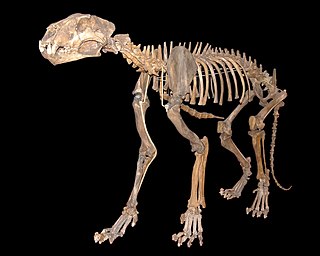
A mammoth is any species of the extinct elephantid genus Mammuthus. They lived from the late Miocene epoch into the Holocene about 4,000 years ago, and various species existed in Africa, Europe, Asia, and North America. Mammoths are distinguished from living elephants by their spirally twisted tusks and in at least some later species, the development of numerous adaptions to living in cold environments, including a thick layer of fur.

Elephantidae is a family of large, herbivorous proboscidean mammals collectively called elephants and mammoths. These are large terrestrial mammals with a snout modified into a trunk and teeth modified into tusks. Most genera and species in the family are extinct. Only two genera, Loxodonta and Elephas, are living.

The Barbary macaque, also known as Barbary ape, is a macaque species native to the Atlas Mountains of Algeria, Tunisia and Morocco, along with a small introduced population in Gibraltar. It is the type species of the genus Macaca. The species is of particular interest because males play an atypical role in rearing young. Because of uncertain paternity, males are integral to raising all infants. Generally, Barbary macaques of both sexes and all ages contribute in alloparental care of young.

Palaeoloxodon is an extinct genus of elephant. The genus originated in Africa during the Early Pleistocene, and expanded into Eurasia at the beginning of the Middle Pleistocene. The genus contains some of the largest known species of elephants, over 4 metres (13 ft) tall at the shoulders, including the African Palaeoloxodon recki, the European straight-tusked elephant and the South Asian Palaeoloxodon namadicus. P. namadicus has been suggested to be the largest known land mammal by some authors based on extrapolation from fragmentary remains, though these estimates are highly speculative. In contrast, the genus also contains many species of dwarf elephants that evolved via insular dwarfism on islands in the Mediterranean, some only 1 metre (3.3 ft) in height, making them the smallest elephants known. The genus has a long and complex taxonomic history, and at various times, it has been considered to belong to Loxodonta or Elephas, but today is usually considered a valid and separate genus in its own right.

Stegodon is an extinct genus of proboscidean, related to elephants. It was originally assigned to the family Elephantidae along with modern elephants but is now placed in the extinct family Stegodontidae. Like elephants, Stegodon had teeth with plate-like lophs that are different from those of more primitive proboscideans like gomphotheres and mammutids. The oldest fossils of the genus are found in Late Miocene strata in Asia, likely originating from the more archaic Stegolophodon, subsequently migrating into Africa. While the genus became extinct in Africa during the Pliocene, Stegodon remained widespread in South, Southeast and East Asia until the end of the Pleistocene.

Gomphotheres are an extinct group of proboscideans related to modern elephants. They were widespread across Afro-Eurasia and North America during the Miocene and Pliocene epochs and dispersed into South America during the Pleistocene as part of the Great American Interchange. Gomphotheres are a paraphyletic group that is ancestral to Elephantidae, which contains modern elephants, as well as Stegodontidae. While most famous forms such as Gomphotherium had long lower jaws with tusks, which is the ancestral condition for the group, some later members developed shortened (brevirostrine) lower jaws with either vestigial or no lower tusks, looking very similar to modern elephants, an example of parallel evolution, which outlasted the long-jawed gomphotheres. By the end of the Early Pleistocene, gomphotheres became extinct in Afro-Eurasia, with the last two genera, Cuvieronius ranging from southern North America to western South America, and Notiomastodon having a wide range over most of South America until the end of the Pleistocene around 12,000 years ago, when they became extinct following the arrival of humans.

Panthera spelaea, also known as the cave lion or steppe lion, is an extinct Panthera species that most likely evolved in Europe after the third Cromerian interglacial stage, less than 600,000 years ago. Genetic analysis of ancient DNA has revealed that while closely related, it was a distinct species genetically isolated from the modern lion occurring in Africa and Asia, with the genetic divergence between the two species variously estimated between 1.9 million and 600,000 years ago. It is closely related and probably ancestral to the American lion. The species ranged from Western Europe to eastern Beringia in North America, and was a prominent member of the mammoth steppe fauna. It became extinct about 13,000 years ago.

Gigantopithecus is an extinct genus of ape that lived in southern China from 2 million to approximately 300-200,000 years ago during the Early to Middle Pleistocene, represented by one species, Gigantopithecus blacki. Potential identifications have also been made in Thailand, Vietnam, and Indonesia. The first remains of Gigantopithecus, two third molar teeth, were identified in a drugstore by anthropologist Ralph von Koenigswald in 1935, who subsequently described the ape. In 1956, the first mandible and more than 1,000 teeth were found in Liucheng, and numerous more remains have since been found in at least 16 sites. Only teeth and four mandibles are known currently, and other skeletal elements were likely consumed by porcupines before they could fossilise. Gigantopithecus was once argued to be a hominin, a member of the human line, but it is now thought to be closely allied with orangutans, classified in the subfamily Ponginae.

Anancus is an extinct genus of "tetralophodont gomphothere" native to Afro-Eurasia, that lived from the Tortonian stage of the late Miocene until its extinction during the Early Pleistocene, roughly from 8.5–2 million years ago.

Mammuthus meridionalis, sometimes called the southern mammoth, is an extinct species of mammoth native to Eurasia, including Europe, during the Early Pleistocene, living from around 2.5 million years ago to 800,000 years ago.

Mammuthus trogontherii, sometimes called the steppe mammoth, is an extinct species of mammoth that ranged over most of northern Eurasia during the Early and Middle Pleistocene, approximately 1.7 million-200,000 years ago. One of the largest mammoth species, it evolved in East Asia during the Early Pleistocene, around 1.8 million years ago, before migrating into North America around 1.5 million years ago, and into Europe during the Early/Middle Pleistocene transition, around 1 to 0.7 million years ago. It was the ancestor of the woolly mammoth and Columbian mammoth of the later Pleistocene.

The Sardinian dhole is an extinct insular canid which was endemic to what is now the Mediterranean islands of Sardinia and Corsica during the Middle-Late Pleistocene. It went extinct at the end of the Pleistocene around the time of human settlement of the islands.

Megalenhydris barbaricina is an extinct species of giant otter from the Late Pleistocene of Sardinia. It is known from a single partial skeleton, discovered in the Grotta di Ispinigoli near Dorgali, and was described in 1987. It was larger than any living otter, exceeding the size of South American giant otters (Petrolutra), which can reach two meters in length. The species is one of four extinct otter species from Sardinia and Corsica. The others are Algarolutra majori, Lutra castiglionis and Sardolutra ichnusae. It is suggested to have ultimately originated from the much smaller European mainland species "Lutra" simplicidens, which may be more closely related to Lutrogale than to modern Lutra species. The structure of the teeth points to a diet of bottom dwelling fish and crustaceans. A special characteristic of the species is the flattening of the first few caudal vertebrae. This might point to a slightly flattened tail.
Microtus (Tyrrhenicola) henseli is an extinct species of vole belonging to the genus Microtus that was endemic to Sardinia and Corsica during the Pleistocene and Holocene.

Canis etruscus, the Etruscan wolf, is an extinct species of canine that was endemic to Mediterranean Europe during the Early Pleistocene. The Etruscan wolf is described as a small wolf-like dog.
This paleomammalogy list records new fossil mammal taxa that were described during the year 2018, as well as notes other significant paleomammalogy discoveries and events which occurred during that year.
This paleomammology list records new fossil mammal taxa that were described during the year 2021, as well as notes other significant paleomammology discoveries and events which occurred during 2021.

Enhydrictis is a genus of extinct mustelid, belonging to the subfamily Galictinae. The type species, and best known, is Enhydrictis galictoides from the Pleistocene of Sardinia and Corsica. Some authors attribute species from mainland Eurasia to the genus, but this is disputed, with others considering the genus endemic to Sardinia-Corsica.
This paleomammology list records new fossil mammal taxa that were described during the year 2022, as well as notes other significant paleomammalogy discoveries and events which occurred during 2022.
This article records new taxa of fossil mammals of every kind that are scheduled to be described during the year 2023, as well as other significant discoveries and events related to paleontology of mammals that are scheduled to occur in the year 2023.















